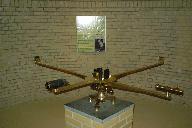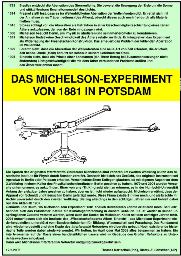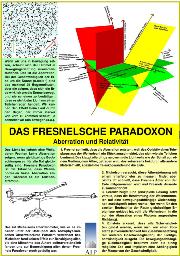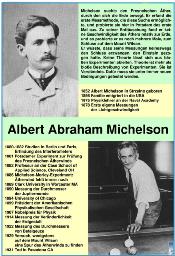The Michelson experiment in Potsdam (1881)
The explanation of the aberration of star light requires in the wave picture to suppose a carrier medium (the ether) for light waves which freely floates through any matter. Fresnel brought himself to advance this hypothesis because otherwise the aberration of star light had contradicted the wave theory. Reluctantly the utopic property of the ether was accepted. Michelson showed with his now famous experiment, that Fresnel's hypothesis cannot be upheld. The ether (whose existence was not doubted) is dragged along with the earth and enclosed by walls just as the common sense expects. Fresnel's explanation of the aberration of star light is shown to be wrong. In Michelson's words:The interpretation of these results is that there is no displacement of the interference bands. The result of the hypothesis of a stationary ether is thus shown to be incorrect, and the necessary conclusion follows that the hypothesis is erroneous.
This conclusion directly contradicts the explanation of the phenomenon of aberration which has been hitherto generally accepted, and which presupposes that the earth moves through the ether, the latter remaining at rest.
The experiment was performed 1881 here in Potsdam in the cellar below the eastern dome of the former Astrophysical Observatory Potsdam. It was improved later several times, in particular by Michelson, and Michelson's interferometer technique is still the most precise to measure length changes.
The experimental setup is rather simple. By observation if the interference of two light waves, the relative changes between to paths can easily be controlled. One wave takes a path transversal to the motion of the earth through the supposed ether (back and forth), the other one takes a longitudinal path. To this end, a light beam is splitted by a half-transparent mirror. Both parts are reflected in some distance L by mirrors, so that they can be brought to interfere.
One assumes that the apparatus moves with the velocity v (the velocity of the earth on its orbit around the sun is about 30 km/s) with respect to the ether. The speed ogf light is denoted by c (300000 km/s). When the beam transversal to the motion arrives at his mirror, it passed also the distance the ether drifted. By Pythagoras, c2ttrans2 = Ltrans2 + v2ttrans2. The beam in the direction of motion has to pass first ctforth = Llong + vtforth, and back ctback = Llong - vtback.
We obtain
ttrans2 = Ltrans2 / (c2 - v2),
tforth = Llong/(c-v) und
tback = Llong/(c+v). The difference in path is found to be
2 cttrans - ctforth - ctback = 2Ltrans/sqrt(1-(v/c)2) -Llong/(1-v/c) - Llong/(1+v/c) approx 2Ltrans(1+(1/2)(v/c)2) - 2Llong(1+(v/c)2)
When the apparatus is turned, the paths vary with the position of the arms. The interference pattern should show this, but the expected change does not appear.
The ether is dragged along by the earth jats as the air in the fur of an animal dragges along the air near the skin. What is disturbing here? It is a small astronomical effect, the aberration of star light. Bradley found in 1729 that the light behaves (just as Newton expected) like a stream of particles. Their direction of incidence seems to change with the motion of the observer. Everybody observes this with his umbrella, which has to be inclined forward when one is walking in the rain. This effect, the aberration of star light, was hailed as backing of both Newton's emenation theory of light and Copernicus's hypothesis of the motion of the earth around the sun.
Some decades later, Thomas Young and later Auguste Fresnel put forward the wave theory of light, because only a wave theory could explain the the interference phenomena. It was simple now to explain reflection and refraction with Huygens's construction which we know from college textbooks. Only the aberration left unexplained. In the wave theory of this time, there is no aberration of wave fronts. Fresnel was forced to suppose a carrier medium which moved freely and undisturbed through the even densest matter, in particular through the body of a telescope. Then, the aperture of the telescope cuts a part of the wave front, which now swims in this ether like a wave crest, and the aberration is found again like in a stream of particles. At Fresnel's time this was sufficient, because wave-front sensors were unknown.
Just this excuse with the freely floating ether was rejected by the Michelson experiment. The aberration problem returned as open again. Einstein's theory of relativity solved the question more geometrico, whithout refering to any ether and its properties, by the relativity of simultaneity. When one requires that the aberration of wave fronts is identical with the aberration of a particle strem, one obtains the theory of relativity.
Michelson,A.A.: The relative motion of the Earth and the luminiferous ether, The American Journal of Science 22 (1881), 120-129.
Michelson,A.A.: Die Relativbewegung der Erde gegen den Lichtäther, Deutsche Übersetzung mit einem Vorwort von A.H.Compton und einem Nachwort von M.v.Laue, Die Naturwissenschaften 19 (1931, Heft 38), 777-784.
Bleyer,U., Gottlöber,S., Haubold,H.-J., Hempelmann,A., Mücket,J.-P., Müller,V., Stoll,D.: Zur Geschichte der Lichtausbreitung, Die Sterne 55(1979), 24-40.
Zum historischen Umfeld:
P.Brosche, D.-E.Liebscher: Fallstricke der Aberration
Reconstruction, in the cellar under the eastern dome of the AOP (now PIK) on the Telegrafenberg

and some posters (in german)

Handout in pdf

Handout in pdf
